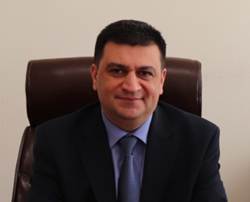Armenia pioneers ePM to obtain a better understanding of performance
People Story
Vol 32 No 2 2022
9 December 2022
 The Armenian nuclear power plant consists of two units with a WWER-440 reactor, model V-270 (which is the seismically upgraded model of the first-generation V-230 unit). From 2016, we have been carrying out phased modernisation works to extend the plant’s operational life. Extended outages, and a large number of works on primary circuit equipment all lead to an inevitable decrease in the WANO Index, which currently stands at 73,9.
The Armenian nuclear power plant consists of two units with a WWER-440 reactor, model V-270 (which is the seismically upgraded model of the first-generation V-230 unit). From 2016, we have been carrying out phased modernisation works to extend the plant’s operational life. Extended outages, and a large number of works on primary circuit equipment all lead to an inevitable decrease in the WANO Index, which currently stands at 73,9.
In December 2020, a meeting was held between our counterparts at WANO Moscow Centre and the management of HAEK CJSC, which operates the Armenian plant. As a result, we agreed to participate in the testing of Enhanced Plant Monitoring (ePM) and Organisational Diagnostics, under the WANO and industry’s initiative Action for Excellence (AfE).
We jointly developed the ePM plan which included the experts to work on the pilot at the station and WANO. Moscow Centre provided training to us on the methodology and indicators used for ePM. We defined the data management procedure for ePM indicators and data transmission channels for ePM data. In particular, the WANO Representative delivered great support to us in the implementation of the process and in coordination with Moscow Centre.
Work on the calculation of ePM indicators was organised at the plant. At the end of each quarter in 2021, a meeting of the people responsible for calculating the indicators took place to present the numerical values of the ePM indicators, which were discussed and analysed. We identified some inaccuracies in the algorithm for calculating the ePM indicators and provided feedback to WANO. Four collegial review meetings were held, and three support measures were proposed based on the results of the monitoring, two of which have already been conducted.
As is often the case with a pilot, not everything went smoothly. Some ePM indicators had not been used at the station previously. Some of them were missing and others – due to the lack of method or software – were estimates and relied on subjective analysis. As information on reported events is often provided late or in preliminary reports, this makes it difficult to make decisions on monitoring and supporting the plant.
Furthermore, due to COVID-19 restrictions, it was not possible for the functional experts to visit the station directly, and as the station was focused on lifetime extension work, no direct online contact was made with the experts, and all interactions were carried out online through the WANO Representative.
For this reason, the gaps, causes and actions of some open areas of concern (AOC) were repeated information based on the results of the last Peer Review. As a consequence, remote ePM in this situation was not as effective as it could have been. In future, direct physical access of WANO experts to the plant in Armenia should be arranged to overcome these challenges.
After analysing the results from the pilot stations, WANO Moscow Centre will provide guidance on any further adaptation of ePM to fit the operating conditions of member stations. Gradually, new stations will be involved in the process.
In summary, I would like to reinforce my station’s positive attitude to ePM as a key tool in the industry’s performance improvement initiative. It is important to consider not only the adaptation of the ePM process for each Regional Centre, but also for each member.
For my station in Armenia, it is correct to compare your performance today with yesterday, to understand what performance is likely to be tomorrow. This is where we can all see the goal and benefit of ePM. We look forward to continuing to integrate ePM to enhance plant performance.
Artur Grigoryan
Chief Engineer, Armenia nuclear power plant